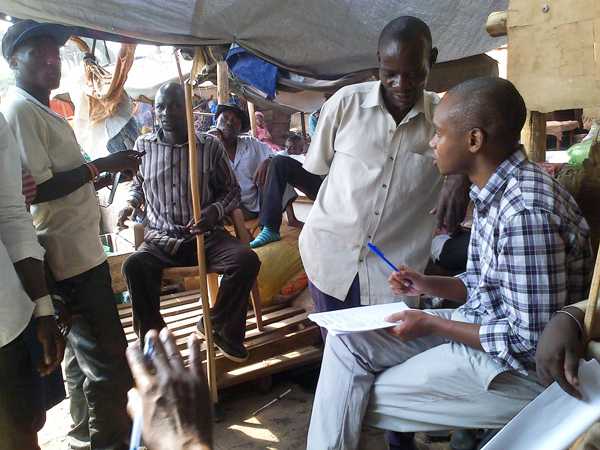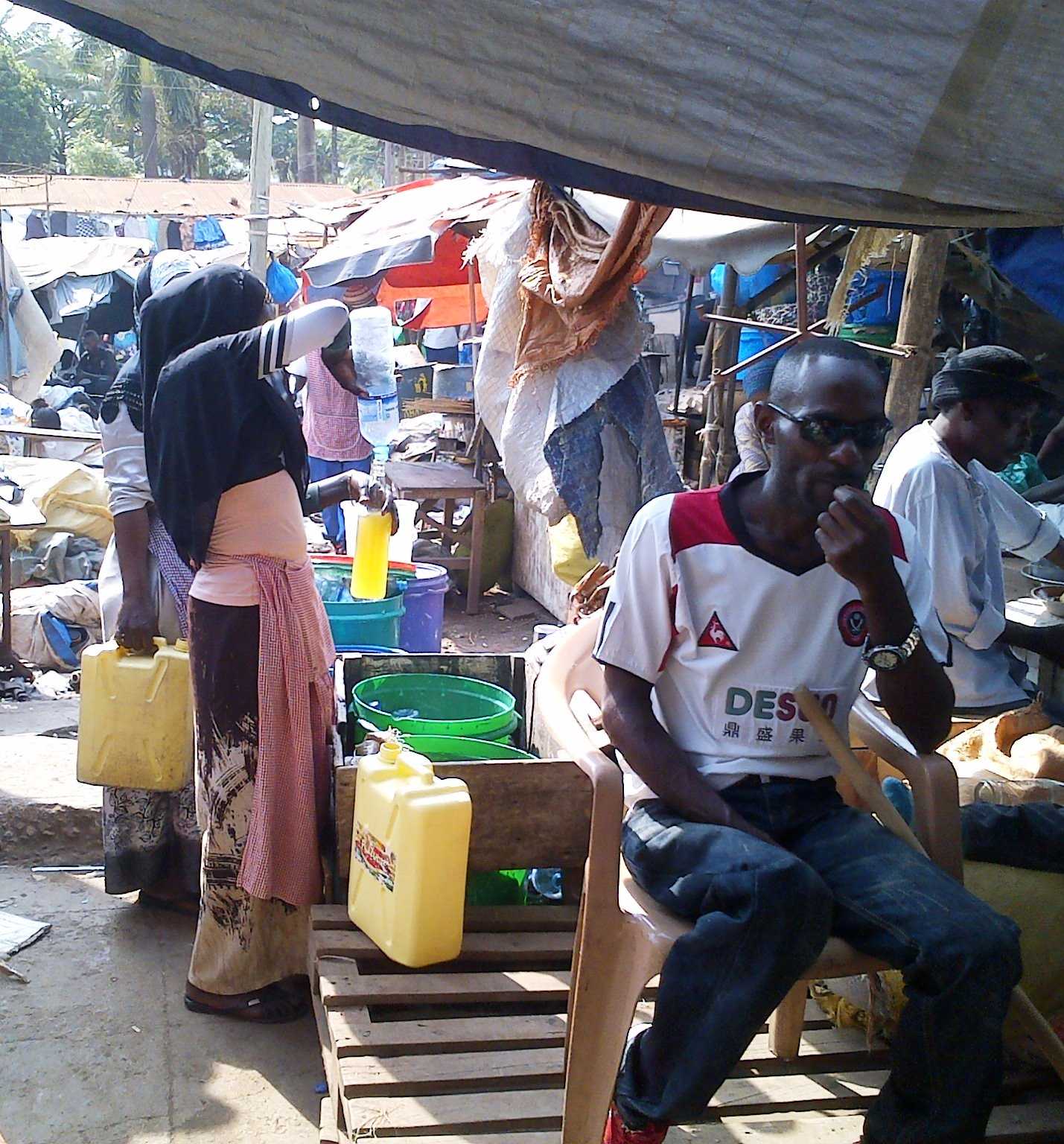Uganda FETP Gets Crash Course in Disease Detection

Dr. Benon Kwesiga (r) conducts interview in Disableds Market
Related Links
On February 6, 2015, the Uganda Ministry of Health (MOH) received word of a “strange disease” that had killed one person, sickened dozens of people and seemed to be spreading quickly in the bustling area surrounding Kampala’s “old taxi park”—a crowded spot in the central business district where the city’s ubiquitous “matatus” (or shared taxis) gather to load and unload passengers. The affected patients were presenting symptoms such as abdominal pain, vomiting, prolonged high fever, jaundice, and diarrhea. Fearing that it might have been an outbreak of a viral hemorrhagic fever such as Ebola which was still raging in West Africa, MOH, with the help of the Uganda Virus Research Institute, conducted a battery of laboratory tests; all came up negative. So the cause of the illness remained a mystery—but not for long.
Across town, at the Makerere University School of Public Health, the Uganda Public Health Fellowship Program (PHFP)—a partnership with MOH supported by the U.S. Centers for Disease Control and Prevention (CDC) through the U.S. President’s Emergency Plan for AIDS Relief (PEPFAR)—was just starting the second week of the Introductory Course for its very first cadre of aspiring “disease detectives” through a Field Epidemiology Track (FET) introduced just a month earlier. PHFP-FET is Uganda’s Field Epidemiology Training Program (FETP), a two-year, learning-through-doing, post-graduate program closely modeled after CDC’s Epidemic Intelligence Service (EIS), which aims at training the country’s next-generation of public health leaders who will leave the course with skills applicable to everything from HIV/AIDS to health security programs. Within days, in the storied tradition of EIS, these young Fellows would trade didactic lessons for disease detection as they took on the outbreak investigation and, in short order, identified this “strange disease” as typhoid fever and contaminated water as its source.

Dr. Zhu greets community leader during outbreak investigation
Joining the Typhoid Response
Typhoid fever is a potentially fatal disease caused by the bacterium Salmonella Typhi, is food- or waterborne, and is typically the result of poor sanitation and hygiene. The disease is endemic in Uganda, with occasional outbreaks such as one in the western part of the country that was identified in 2008. This current outbreak had likely started as early as December 2014 and had been spreading in central Kampala undetected. When MOH formally asked the PHFP-FET team (along with their CDC-Uganda resident advisor, Bao-Ping Zhu, MD, PhD, MS) to investigate the outbreak on February 10, the disease had already sickened hundreds in the city. “The Fellows had barely settled into their classroom at the School of Public Health when they were called in to respond to a major challenge,” says Dr. Zhu. “Conducting this outbreak investigation not only allowed them to substantively contribute to a public health emergency response but also provided them an opportunity to gain invaluable real-world experience in applied field epidemiology.”
Identifying the Source
The Fellows immediately dove into the outbreak response, visiting the affected communities and reviewing patient information from the treatment centers. They visited Namungona Orthodox Hospital in Kampala—where the index patient had died—to interview the doctor and gather information about the patient’s clinical manifestations. At the hospital, they found another patient admitted with high fever and severe abdominal pain whose husband had had similar symptoms a few days before her onset. In interviews with the team, the patient reported numerous similar cases and deaths in her workplace. Meanwhile, another part of the team identified 18 additional patients with similar symptoms in nearby market areas and health centers. “After seeing the hospitalized patient and other sick people in the markets, we immediately realized this was likely a typhoid fever outbreak, and took blood specimens for laboratory testing,” says Dr. Zhu. “However, at that time we had no idea thousands of people had already been infected.”

Kampala Taxi Park
As the outbreak investigation progressed, the epidemic curve indicated continuous common-source exposure, and certain demographic details of those affected became evident. Patients were primarily adults (more males than females) with diverse places of residence but with places of work in common—mainly two market areas near the taxi park. Modes of exposure also began to take shape, so the Fellows then carried out a carefully designed case-control study where they compared the usual food and water intake of sick people to that of healthy people.
Twenty-six percent of patients and only 2.6% of controls regularly consumed “amazzi ga kaveera,” which is water packaged in small polythene bags that is sold on the streets of Kampala. Similarly, more than half of patients and only 19% of controls drank locally-made passion-fruit juice (known as “Katunda”). The odds of getting sick also increased with increase in the number of types of locally made drinks consumed. The investigation also revealed that local vendors routinely extract water from underground sources without chlorination to make these popular and inexpensive drinks, therefore, the Fellows collected samples of these beverages as well as locally produced pineapple juice (“Munanansi”) and cold millet porridge (“Bushera”) along with underground water and sent them for laboratory testing. All were found to have heavy fecal contamination. Eight blood specimens also tested blood-culture positive for Salmonella Typhi. No foods were associated with illness.

Extracting water from unknown underground source
The answer was clear: this was a typhoid outbreak caused by consumption of drinks made from contaminated water. The PHFP-FET team recommended sealing off all underground water sources and supplying free, chlorinated water to affected areas. With the source of the outbreak identified, MOH worked with partners to activate the CDC-supported Public Health Emergency Operations Center, establish six free treatment centers, seal off underground water sources, and provide chlorinated water to the areas affected by the outbreak. The team—along with staff from CDC-Uganda and a team sent from CDC headquarters—began to address other critical elements of the response such as assessing the true scope of the outbreak and the risk of its spread by affected people returning from Kampala back to their home villages or far-flung districts and by working to identify how the water became contaminated. At the urging of the PHFP-FET team and CDC staff, MOH and Kampala’s municipal authorities also began to promote critical health education campaigns to urge the public to drink safe water including sealed bottled water from supermarkets, to avoid drinking unsafe water and juice from local markets, and to boil or treat their drinking water at home. The CDC team, along with MOH, worked with Uganda’s National Water and Sewerage Corporation to determine whether or not water from its taps also contained fecal contamination (it did not). “This outbreak investigation and response have been successful because of a genuine collaboration among CDC, MOH, and many other partners, and our disease detective trainees have been integral to this team,” says CDC-Uganda Country Director Steven Wiersma, MD, MPH. “And this isn’t a short-term engagement for these Fellows; the beauty of this program globally is that the majority of its graduates will work as senior health managers within their countries—this is sustained, deeply-rooted impact for long term public health capacity building.”
Lessons Learned
By late May, the total number of suspect cases had topped 14,000, but the epidemic curve showed that the outbreak was waning. But even as the case count decreased, work remained to be done to prevent another occurrence in the future. This outbreak—like all typhoid fever outbreaks—highlights shortcomings in sanitation and safe water. While, in the short term, there was an urgent need for interventions to interrupt the spread of infection—specifically immediate provision of safe water—long-term investment in expanding infrastructure for water and sewage systems is critical in the rapidly growing urban setting of Kampala, and use of typhoid vaccines should also be considered. CDC’s technical assistance during this outbreak also highlighted a critical need to train Ugandan health professionals in diagnosis and appropriate treatment (i.e., the right antibiotic at the right dose for a full course) as well as for public health officials to monitor for antibiotic resistance as CDC detected concerning rates of resistance to standard antibiotics in many of the samples it tested.

Using reused bottle from street to make Butunda
So lessons have been learned—but perhaps none more valuable than those learned by the PHFP-FET Fellows. This “crash course” in applied field epidemiology has provided the sort of hands-on experience one can never fully gain in a purely academic setting—and which makes Field Epidemiology Training Programs worldwide so unique and valuable. “This assignment was a classic example of how field epidemiology can directly influence public health practice, but, more than that, it also demonstrated how effective practical learning can be,” says Steven Kabwama, a PHFP-FET Fellow attached to the Mental Health & Substance Abuse section of MOH. “None of us had any experience in outbreak investigation, and yet, with good mentorship from CDC’s Dr. Zhu and other experts, we managed to uncover an outbreak that affected thousands of people in Kampala.”
As the outbreak came under control and the Fellows returned to their classroom to finish their studies with new perspective and new insight on their work, they were assigned to their positions within MOH to solve practical public health problems. But they had scarcely settled into their assignments when some of the team, along with their CDC advisor, was deployed to western Uganda to investigate an outbreak of cholera—and to continue learning by doing great work in public health. With typhoid and cholera under their belts, PHFP-FET has already been identified by MOH as a key partner in assisting the Government of Uganda with implementation of its Global Health Security Agenda plan in the near future.
- Page last reviewed: June 12, 2015
- Page last updated: June 12, 2015
- Content source:
Global Health
Notice: Linking to a non-federal site does not constitute an endorsement by HHS, CDC or any of its employees of the sponsors or the information and products presented on the site.


 ShareCompartir
ShareCompartir